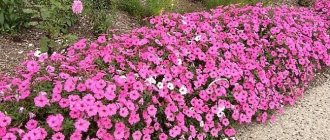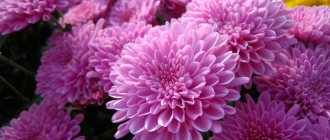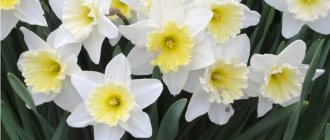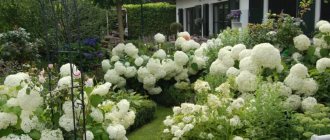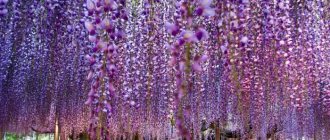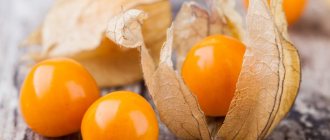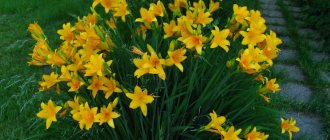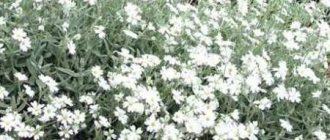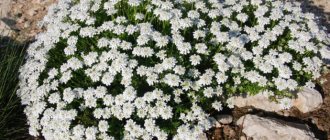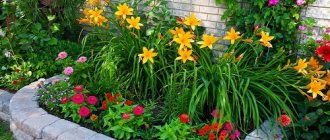The beauty of landscape design is favorably emphasized by flower crops. They are used for flower beds, hedges, and garden sculptures. Planted in flower pots, flowerpots, along fences and buildings.
The design is created from a wide variety of flowering plant species. They are selected according to flowering time, shape of inflorescences and leaves, and height. Gardening work requires a lot of time and effort so that the appearance of ornamental plants serves as decoration for a long period.
Advice! In order not to make a mistake with your choice, it is recommended to first study the characteristic features and, if possible, check the quality of the soil in your area.
But it is not always possible to regularly take care of your favorite flowers, and choosing perennials as garden and plot decoration is a rational and practical decision. Plants planted once will delight the eye for many years, and in the spring there will be no need to worry and plan new plantings. And the right choice of varieties will ensure colorful flowering throughout the growing season. A distinctive advantage of perennial flowers is their intensive growth rate and the ability to grow and reproduce in almost any conditions.
The most unpretentious perennials
Any garden crop needs care, but choosing unpretentious perennials can save you a lot of unnecessary hassle. The main requirement in this case is the right choice. Selection criteria:
- seasonal decoration;
- site features;
- flowering duration;
- illumination of the garden plot;
- timing and method of planting;
- location;
- soil quality;
- climatic regional features.
Advice! If it is not possible to provide regular watering to flower beds or there is no time for care, it is better to choose drought-resistant varieties.
There is a misconception that unpretentious varieties are less decorative and spectacular. In fact, among them there are the brightest and most colorful, amazingly beautiful flowers:
- Garden chamomile (Nivyanika). One of the most popular flowers will definitely delight you with a long flowering period.
- Hosta. The leaves of the compact flower bush are of amazing shape and beauty, not in inflorescence; although they are attractive, they are inferior in appearance to the foliage. There are many varieties of hosta.
- Loosestrife. The tall crop amazes with the grandeur of its spike-shaped inflorescences. The active growing season is until late autumn. The winter-hardy crop has an accelerated growth rate.
- Sedums. Both inflorescences and leaves are decorative. Easily takes root on any type of soil. The drought-resistant plant can grow both in the sunny side and in partial shade.
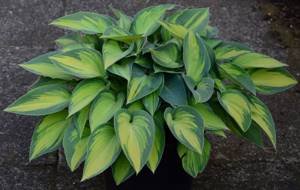
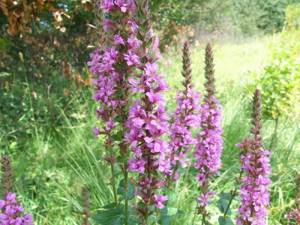
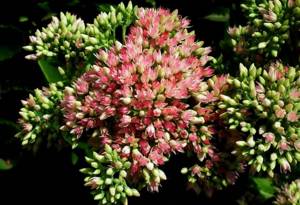
Before planning planting work, it is necessary to first prepare the soil: lower or increase acidity, add sand, peat or humus.
Alyssum Clea Crystal Parple Shades
The name is not yet the most surprising thing about this unique tetraploid alyssum. Wow! So many unfamiliar words at once.
My first acquaintance with alyssum did not go well. I didn’t get the expected fragrant cloud over the flowerbed. And I didn’t notice any special beauty either. White alyssum reminded me a lot of weeds from the cruciferous family.
But this is what I would plant.
Alyssum
Clea Crystal Parple Shades is as unpretentious as regular alyssum and is fragrant. But the flowers are larger, the inflorescences are so lush that because of them the leaves are almost invisible.
You can sow directly into the ground in April-May. But the seeds are small - it’s better to put them in pots first so as not to lose the seedlings.
Bulbous perennials
Perennial flower crops are united by the presence of a bulb - the underground part of the plant, the main material for propagation. It is in the bulbs that there is a complex of substances necessary for growth and flowering. Divided into 3 types:
- bulbous;
- small-bulbous;
- corms.
Under favorable conditions they reproduce intensively. To preserve the main characteristics, the “babies” formed in the queen cells must be separated. They reproduce by dividing bulbs, have different flowering periods, are particularly unpretentious and able to grow on any soil.
- Tulips. Familiar and popular crops are distinguished by a huge number of varieties and a short flowering period.
- Daffodils. They bloom in late spring, almost simultaneously with tulips. Fragile steles and delicate inflorescences are not afraid of frosts down to -5 degrees.
- Goose onion. Compact flowers with narrow pointed leaves and small yellow flowers.
- Irises. One of the most unpretentious representatives of the flora. They grow in absolutely any area. They can go without watering for a long time. They multiply quickly and do not require care during this season.
- Imperial hazel grouse. An early species of perennial representatives, with a high, up to 1 m peduncle. The flowers are bell-shaped, multiple, located on the upper part.
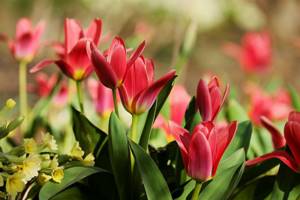
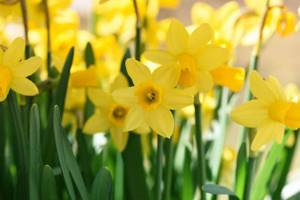
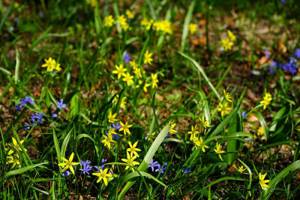
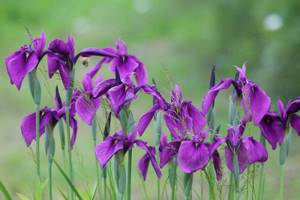
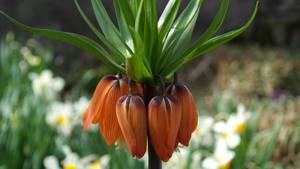
Advice! As it grows, it is necessary to dig out and divide the resulting bulbous nest, otherwise the flowers will begin to become smaller and suppressed.
Depending on the region, the root system is dug up for winter storage or left in the soil - this is done in regions with moderate winters.
Tips for decorating a flower bed
First of all, you need to decide on the location of the flower bed, its shape and dimensions. Calculate how many bushes can be placed on it.
To make the flower bed look attractive throughout the spring and summer, you will need to select plants with different flowering periods. If you want to get intense simultaneous flowering of all types, you will have to select varieties whose flowering schedule coincides.
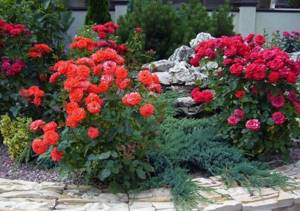
If you want to choose only red flowers for your flower bed, it is recommended to choose crops that differ in shape and color intensity of leaves and flowers. Plants should not be planted randomly. You must first draw up a plan taking into account the characteristics of each type of green space and strictly adhere to it.
To obtain a more advantageous landscape composition, designers still recommend diluting it with bright shades:
- refresh the picture with blue and white colors;
- yellow and red will create an attractive duet that will be difficult to take your eyes off;
- orange will add even more dynamics and energy.
Red flowers for a flower bed can be used low or tall. If desired, you can plant perennial or annual plants that reproduce by seeds. Monochrome compositions composed of varieties that begin to bloom alternately will delight the eye throughout the summer. When choosing plants, you should take into account the duration of their flowering period.
By season
It is recommended to plant perennial crops taking into account the flowering time. Properly placed flowers on the site will decorate it immediately after the winter cold and until late autumn.
Spring perennials
Unfortunately, spring bulbous crops have a very short life span. For most, the above-ground part quickly fades and withers. When choosing primroses, you should not allocate a large part of the territory to them. It is better to combine them with crops of a later flowering period. Faded inflorescences and yellowed above-ground parts of spring crops are carefully cut off. Most spring flowers are low-growing and highly frost-resistant.
- Crocus. Frost-resistant delicate flower of small size. It multiplies very quickly and needs to divide the bush every 2-3 years. The shades are mostly soft and restrained.
- Snowdrop (galanthus). A primrose with a self-explanatory name can wake up when there is still snow on the site. Delicate bell-shaped flowers are usually white.
- Muscari (mouse hyacinth or viper onion). A delicate plant with graceful racemes and a faint musky aroma.
- Allium (decorative onion). Does not require care, grows on any soil, unpretentious to watering and lighting. Ball inflorescences look harmonious in any flower arrangement.
- Pushkinia (small hyacinth). An elegant flower with small inflorescences consisting of small white flowers. They bloom early and for a short time, spending most of the growing season in dormant mode.
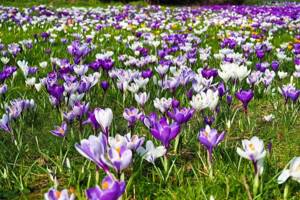
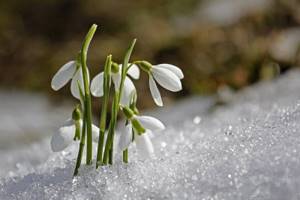
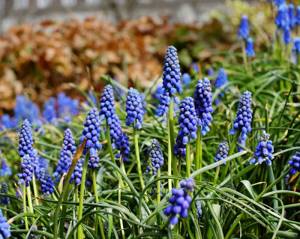

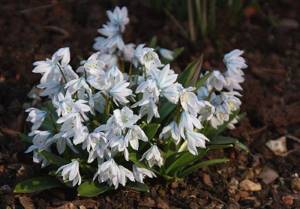
Advice! After the snow melts, the root system of spring perennial flowers often ends up on the ground surface. It is necessary to sprinkle them with earth. Last year's stumps and dried stems are carefully removed so as not to harm the plants.
The main pleasant sign of spring is the appearance of primroses. As a rule, they bloom immediately after the snow melts at a time when other plants are not yet ready to awaken.
Summer
With the onset of summer warmth, larger and more fragrant perennial flowers bloom. The color range is much more varied than that of primroses.
- Lilies. Gorgeous tall flowers with large noble flowers. Up to 15 buds can form in an inflorescence. The shades are very diverse. Drought-resistant, grows only in the presence of sunlight.
- Dahlias. Gorgeous tall plants look gorgeous in any shade and shape of inflorescence. They require obligatory digging of rhizomes.
- Cannes. With sufficient watering, they can reach a height of 2 m. Huge bushes with wide, large leaves throw up a peduncle with exotic inflorescences.
- Gladioli. They also require digging up tubers for the winter. Tall, with many flowers on the peduncle, they always look presentable.
- Hydrangea. This gorgeous plant can be either shrubby or tree-like. There are liana-like varieties reaching a length of 30 m. Flowers are divided into deciduous and evergreen. Huge ball inflorescences look aristocratic and bewitching.
- Peonies. Huge and delicate flowers will grow very quickly on the site. Even after flowering, gorgeous green bushes decorate the area. Look great as a border along garden paths and fences.
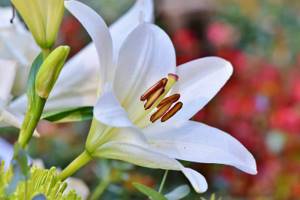
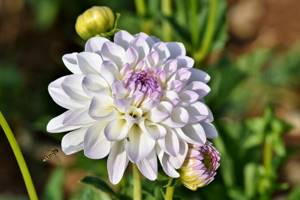
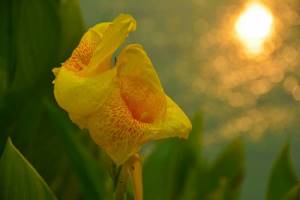
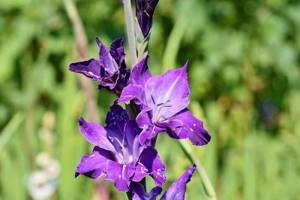
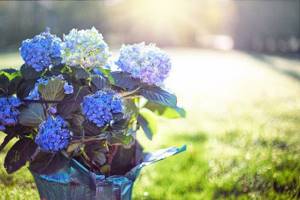
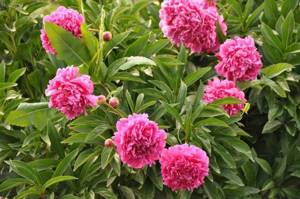
When choosing summer varieties of perennials, you should choose according to growth and size. Compositions usually combine tall and short growing crops.
Advice! When choosing climbing perennials, it is recommended to use them for decorating arches, gazebos, and vertical gardening of walls.
To provide the area with beautiful color for the whole season, choose perennials that bloom all summer:
- Delphinium. It is distinguished by a huge number of shades and long flowering. The inflorescences are dense, consisting of very small flowers, on straight peduncles, up to 70-80 cm high.
- Rudbeckia. There are perennial and annual varieties. Of the perennials, the most common is rudbeckia with yellow and orange flowers. The plant grows well in any type of soil, grows very quickly and requires division every 2-3 years. Blooms from early summer until frost.
- Echinacea. In addition to decorative qualities, it has a complex of medicinal properties. The flowering period is up to 1.5-2 months. The flowers come in white, pink, yellow and purple shades.
- Stock rose (mallow). Drought-resistant and shade-tolerant plants reach a height of 1-1.5 m. The shades of the inflorescences are very diverse: from white to bright red.
- The cuff is soft. It is distinguished by its characteristic lace-like inflorescences and vitality. It can grow on any soil, among stones, and does not require careful care.
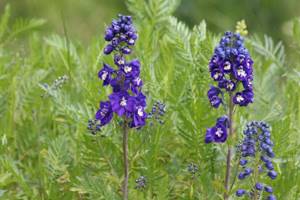
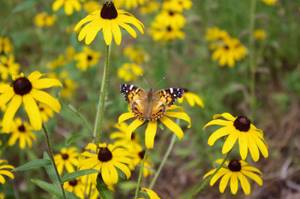
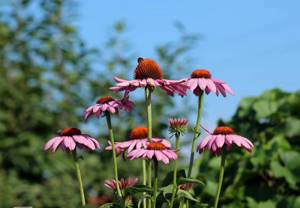
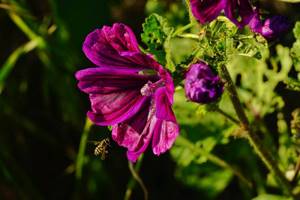
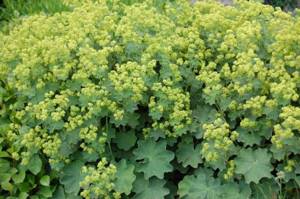
For variety and decorativeness, it is advisable to plant flowers that bloom throughout the summer along buildings and fences, and to form them into living flowering hedges. At the end of the growing season, the aboveground part is simply cut off.
Autumn
Autumn varieties of flowering plants decorate the plots right up to frost. Most crops have the properties of frost resistance and rapid growth.
- Chrysanthemums. A huge number of flowers differ in the size of the inflorescences, the variety of shades and the shape of the petals. Withstands frosts down to -8 degrees. They are characterized by accelerated growth rates.
- Tricyrtis. Tall, erect bushes with exotic inflorescence shapes and many shades. They bloom until frost.
- Crocosmia (Japanese gladiolus). The leaves are sword-shaped, the flowers come in different shades, from lemon to scarlet, and are shaped like large bells.
- Lupine. A tall plant with a large peduncle and many flowers on a spike-shaped inflorescence.
- Snapdragon (antirrium). The name is due to the similarity with the open lion's mouth of small numerous inflorescences.
- Colchicum. It blooms in early autumn and continues to delight with its attractive appearance and delicate flowers until frost.
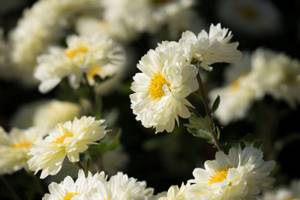
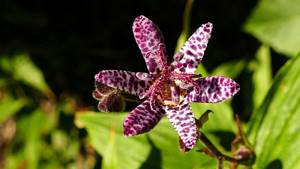
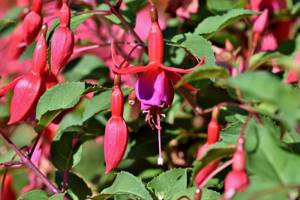
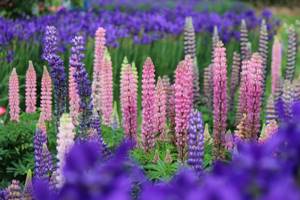
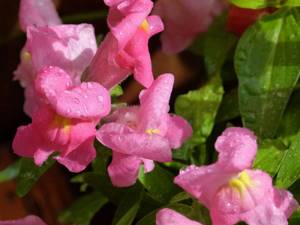
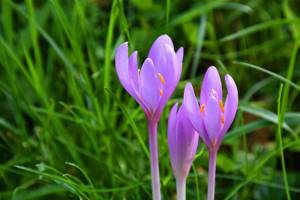
Reference! Autumn perennials are usually frost-resistant, but when growing the crop, regional climatic conditions should be taken into account and, if necessary, the root system should be insulated.
Autumn varieties of perennial garden crops are characterized by rapid growth and long flowering. After the end of the growing season, it is recommended to cut off the above-ground part. It can be propagated both in spring and autumn.
Beautiful flowers of perennial lobelia
I have never seen such lobelia before. Usually grown as an annual, compact, with small flowers, often ampelous. And here there is such beauty - in the bush.
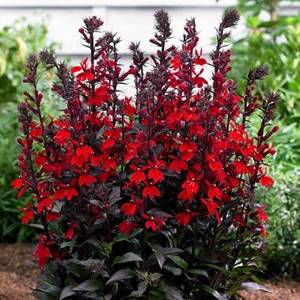
This is a perennial lobelia , frost-resistant, American selection. The height of the bush is up to 80 cm. If grown through seedlings, it will bloom in the first year.
If I find seeds, I will definitely plant them.
Beautiful perennials
Of course, each variety of flowering perennial plants is good in its own way. But only some of the types of flower crops can be called truly beautiful. Although it all depends on taste preferences.
- Rose. She rightfully bears the proud title of “queen of the garden”. They attract and fascinate with their gorgeous flowers and wonderful aroma. In favorable conditions they can bloom 2-3 times during the growing season. There are many forms: short, curly, tall. There are so many shades that it’s difficult to choose the right one right away.
- Gypsophila paniculata. White perennials amaze with their unpretentiousness. Airy and light inflorescences that resemble a cloud are often used by florists to decorate bouquets.
- Rudbeckia "Golden Ball". A yellow perennial garden flower with large spherical inflorescences pleases the eye until frost.
- Poppy. Delicate petals and the unusual shape of the buds attract with their sophistication.
- Lychnis chalcedony. Red perennial with small flowers collected in capitate inflorescences. Flowering time is summer months, mainly June and July. Inflorescences of white and pink shades are less common.
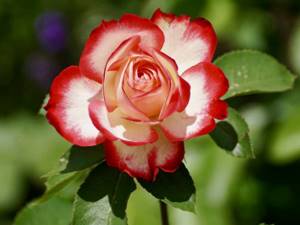
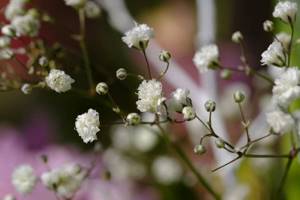
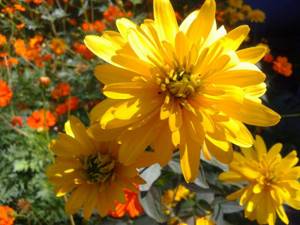
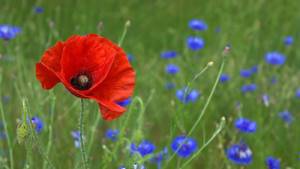
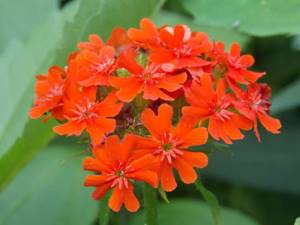
Reference! Today there is a fashionable trend - to select flowers according to color scheme. With the help of a variety of shades and shapes, it is possible to obtain a spectacular and original flower arrangement even from crops of the same type, but of different varieties.
Popular perennials with blue flowers: liverwort, bluebell, perennial aster, forget-me-not. When choosing a color scheme, it is important to take into account the shades in order to get a colorful, bright palette.
Low-growing perennial crops with red flowers
A bright scarlet accent on the most important areas of the garden is an ideal solution for those who are brave and not afraid to experiment. We invite you to get acquainted with the most popular perennial plants, caring for which will bring real pleasure to amateur gardeners.
Low-growing plants are used to decorate borders, alleys, paths; they will perfectly complement the relaxation and recreation area.
Primrose blooms with the onset of the first warmth of spring.
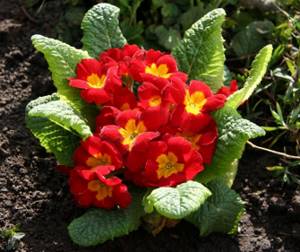
The leaves are pubescent, wrinkled, the flowering is extremely bright and lush. It is recommended to plant the crop on light soils; bushes can be propagated by cuttings, seeds, or division. The distance between the bushes when planting is about 15 cm. The height of adult bushes reaches 10-30 cm, flowering lasts for a whole month, from the first days of April to May.
Cinquefoil is blood red.
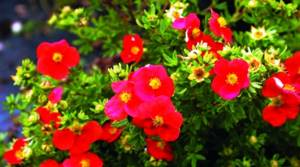
The height can reach half a meter, it has a straight, branched stem. It is distinguished by very bright flowering and a beautiful rich shade of green leaves. The flowers are large, up to 5 cm in diameter, collected in paniculate inflorescences. It blooms in June-July, flowering duration is up to 50 days.
Border chrysanthemums, they are also called Chinese.
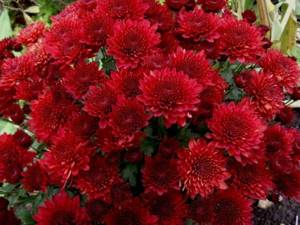
They are attractive due to their long flowering period and resistance to cold. The bushes are low-growing, up to 30 cm tall, and have a spherical shape.
Shade-loving perennials
Sometimes circumstances develop in such a way that plants can only be placed on the site in the shade. In such cases, it is necessary to choose shade-tolerant species.
- Lily of the valley. It even grows under trees and bushes, in the shade of fences, houses, and outbuildings. Characteristic features are wide glossy leaves and curved peduncles with many white bell flowers.
- Badan. A spectacular plant with large round leaves and delicate pink bell-shaped flowers collected in inflorescences. Grows well in the shade and in the sun, the bushes are low, up to 30 cm in height.
- Hellebore. The drought-resistant plant blooms in late spring - early summer, grows in one place for more than 20 years, maintaining its external characteristics.
- Primrose. Refers to early primroses. The drought-resistant flower blooms with white, yellow and red flowers depending on the variety.
- Tradescantia garden. Blooms almost all summer. Unlike the indoor one, it has long and narrow leaves.
- Horny goat weed (zhpimedium, “flower of the elves”). Ground cover perennial with unusual shape and colors of inflorescences. In addition to its decorative function, it has medicinal properties. Flowering period is spring.
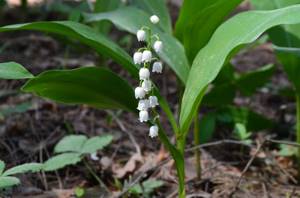

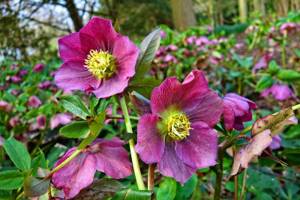

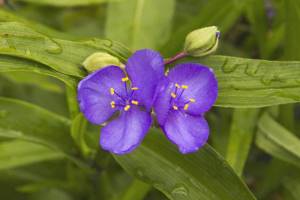
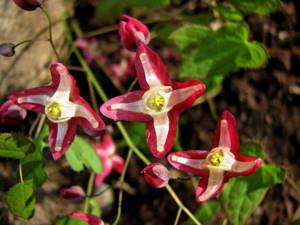
Most shade-tolerant garden crops are very unpretentious; their characteristic distinguishing feature is the spectacular shape and color of the foliage. When creating a site design, you need to select flowers according to height. Low-growing flowers are usually used as a border, planted along the edges of flower beds and flowerpots. Tall varieties are placed closer to the center of the composition.
Marigolds are also beautiful flowers.
Durango mixture - anemone-type flowers. American selection.
Type - rejected. The height of the bushes is 30 cm, the diameter of the flowers is 6 cm.
Snow blizzard - erect marigolds.
The height of the bushes is 35 cm, the diameter of the flowers is 6-8 cm.
I only recently learned about the existence of white marigolds, well, almost white, but the yellow tint still remains. I never tire of reminding you of them, in case someone else doesn’t know.
There are several varieties. I bought Vanilla for myself and saw Eskimo. Against their background, the white blizzard is earlier and in group plantings it looks neater and better aligned.
It has already been written in the comments that white marigolds grow into some kind of indistinct disheveled plants. They probably haven't been selected yet
